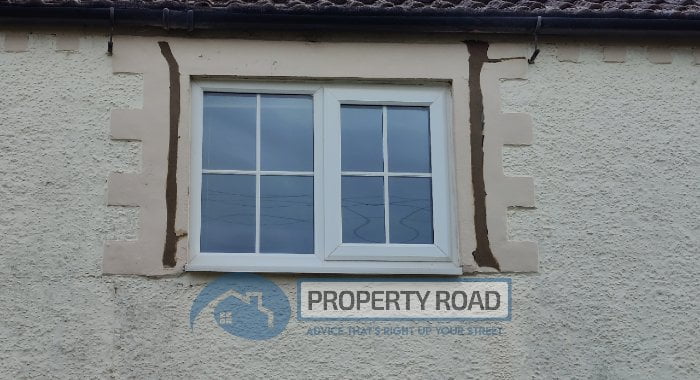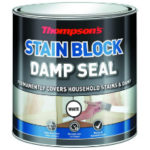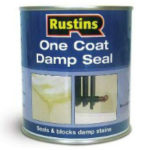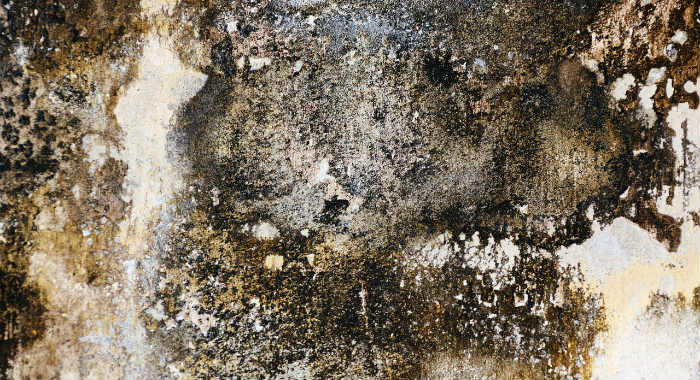With the climate in the UK, knowing how to solve damp problems in houses can be a useful skill to have.
As we live in a relatively wet climate, problems caused by excessive moisture are relatively common in UK property.
If you own or are considering buying a property, knowing about solving damp issues in houses can be very important. After all, if it’s left untreated it can cause serious structural issues. Not to speak of the health hazard it poses.
We had our fair share of damp problems over the years in several houses. So in this article we give you a step-by-step guide on how to solve any damp issues you find based on our own experience.
1. How To Identify Damp Problems

Let’s start with identifying damp. After all, you want to be sure you have a damp problem before you start spending money on solving it.
The first thing you may notice when walking into a property with serious damp or mould issues is the smell.
Damp has quite a distinctive, almost earthy and musty kind of smell. However, you’ll only smell it if it is already quite bad, thankfully, most damp is also easy to identify visually.
Dark mould spots on walls are a dead giveaway, as are yellowish stains. In fact, anything that looks like watermarks on a wall could well be damp. You might also find salt deposits on the wall, which is a sign that water is coming in.
If the wallpaper or paint has become crinkled, that’s another potential indication. Once you know you have damp, you can move on to the next step.
2. Identify The Causes Of The Damp
If you have found damp in your property, you need to know what the cause is. Only then can you move on to treating it.
So, what causes damp in the first place? In short, it’s caused by excessive moisture, be it in the air or through water working its way where it’s not meant to be.
Some of the common causes of damp in houses are:
- Poor ventilation
- Burst pipes
- Blocked or broken guttering
- Leaky roofs or windows
- Rising moisture from the floor
Of course, there are other potential causes too, but the vast majority of cases will be due to one of these things. Depending on the cause, you will have one of three most common types of damp. It’s important to know which one it is, because they are treated differently.
It’s not always easy to identify what causes damp. We know that from experience.
Burkinshaw & Parrett (2003) shed light on some reasons for misdiagnosis, including poor monitoring, erroneous surveying, and cost-cutting measures. Failure to recognize the nature of a damp problem will result in further issues such as damage to property, poor living conditions, and legal disputes.
So if you can’t figure it out yourself, it’s worth getting an expert in to conduct a damp survey. They won’t just tell you the cause, but also how to fix it and what it will cost, which is handy.
3. Common Types Of Damp

The Cherwell District Council discusses the three main types of damp, namely, penetrating damp, rising damp, and condensation. These types of damp commonly affect UK properties.
Let’s take a look at each one in turn…
Penetrating Damp
This is caused by water working its way through walls or via a leaky roof or window.
Usually, signs will appear around the same point as the water is finding its way into the building.
Penetrating damp is almost always caused by poor maintenance such as leaking guttering, blocked drains, or even cracked brickwork.
Rising Damp

As modern properties are built with a protective layer of non-porous ‘blue’ bricks and/or damp proofing, rising damp tends to only affect older properties.
As normal bricks are porous, and therefore let water soak through, in wet conditions, it’s possible for moisture to travel through and up a wall.
This is what gives the name ‘rising’ damp, as it starts at ground level and slowly soaks upwards, seemingly defying gravity!
Condensation
Damp problems linked to condensation are more common in the winter in rooms where there’s more moisture, such as bathrooms and kitchens.
It occurs when the moisture in the air makes contact with a cold wall and condenses back to water.
Over time, the moist conditions can lead to damp and mould problems.
4. Solving The Most Common Causes For Damp

Only when you have established the type of damp and the cause, can you look at how to solve damp problems in houses. As we have said, different types of damp need treating differently.
Penetrating Damp
As this is caused by water coming in from the outside, the way to solve it is to stop this from happening. It can usually be resolved simply with good maintenance.
That means unblocking guttering, repairing leaks, repointing walls and so on.
Rising Damp
Because rising damp is caused by the way your house is built, it’s not something that you can easily fix yourself.
The UK has a well-established industry involved in the treatment of rising damp (Sellers, 2017). We would therefore recommend you consult with an expert and look at getting a damp proof membrane or other damp proof course applied to your walls.
Once this has been installed, you should no longer have a problem with rising damp.
Condensation
Most often, condensation is caused by a lack of ventilation. There are various things you can do to solve the problem:
- Get a dehumidifier, which will remove the moisture from the air to prevent it from causing condensation
- Install a fan in the bathroom or kitchen to draw out the moisture that is produced during showering or cooking
- Install a positive pressure vent
The last option is what we did. We live in a house that was built in the 1850s, so condensation is an issue. The positive pressure vent draws dry air from the loft and pushes it out through any cracks there are in the house.
With the air the moisture is also removed from the house. It’s a solution that will solve the issue for the long-term. But we have noticed that the room with the vent gets quite cold in winter, as the cold air is drawn in.
Damp is a condition that’s only likely to get worse. Therefore, it’s best not to leave it untreated, it’s unlikely to go away on its own.
The sooner you address the issue, the better. Keep in mind though that you’ll need to repair the source of the problem before you fix any cosmetic damage.
The age and structure of your building may also affect how you approach removing moisture issues. This is especially true if you have damp in a listed building.
5. Treating Damp Walls Internally

Once you have found the source of your damp problems and repaired the problem to prevent further damage, you’ll need to repair the cosmetic damage caused to the internal walls.
Be aware though, this isn’t simply a case of painting over the damage straight away.
If you do that, you’ll likely find the paint doesn’t stick to the area that was affected very well. Instead, you’ll have to first thoroughly clean any mould or residue from the affected area using soapy water.
You may also need to carefully sand down the area to get a nice flat finish again.
Then, leave the area to dry out completely (note that this could take weeks or even months!). Keeping the room nice and warm will help speed up the process.
Only once all residue has been removed and the wall has dried out should you attempt to repaint or wallpaper over the affected area.
It’s also recommended to use one of our 5 best damp seal paints before redecorating to help keep future problems at bay.
| Our Rating | Product | Name | Typical Price | Performance | Value For Money | View On Amazon |
|---|---|---|---|---|---|---|
| #1 |  | £11 per litre | Excellent | Outstanding | Check Stock | |
| #2 |  | Polycell One Coat Damp Seal | £17 per litre | Excellent | Good | Check Stock |
| #3 |  | Polar Anti Damp Paint | £23 per litre | Excellent | Average | Check Stock |
| #4 |  | Ronseal One Coat Damp Seal | £11 per litre | Good | Outstanding | Check Stock |
| #5 |  | Rustins One Coat Damp Seal | £31 per litre | Outstanding | Poor | Check Stock |
For walls that have been badly affected, it may be necessary to completely replaster the wall.
Final Thoughts On How To Solve Damp Problems In Houses
Damp is quite a serious issue, given the health problems it can cause when left untreated. We know that it’s not always easy to find the cause of the damp, but doing so must be the first step in solving the problem.
Don’t be tempted to just paint over any damp, even if it means living with signs of damp for months. Because unless you fix the cause of the damp, water will continue to enter your property and the paint job you did will have been a waste of time and money.
Sometimes finding the cause involves a lot of trial and error. We had paint peeling off on the ceiling of our living room for over two years. That’s how long it took us to find the cause and fix it.
It takes so long, because every time you have repaired something that could cause the water to come in, you have to wait for the damp to dry out until you know if water is still coming in.
But if you follow our step-by-step guide, you will eventually find the cause and be able to solve it once and for all.
If the risk of water entering your property is high, you may also be interested in our tips on how to protect your property from flooding.




